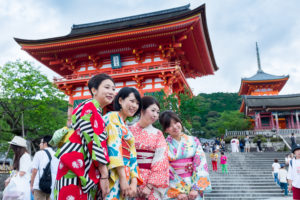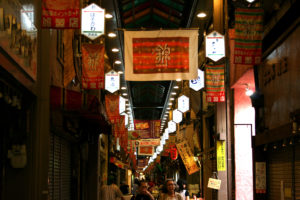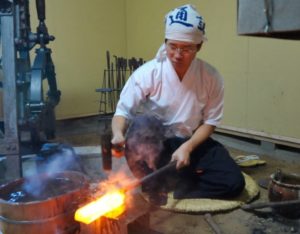Printable Sites Overview Itinerary & Daily Costs
Kyoto 2
Day 7
August 6, 2023
Kyōto, city, seat of Kyōto fu (urban prefecture), west-central Honshu island, Japan. Gently sloping downward from north to south, the city averages 180 feet (55 meters) above sea level. Kyōto fu is at the center of Kinki chihō (region). The city is one of the centers of the Keihanshin Industrial Zone, the second largest urban and industrial agglomeration in Japan. The capital of Japan for more than 1,000 years (from 794 to 1868), Kyōto (literally, “Capital City”) has been called a variety of names through the centuries—Heian-kyō (“Capital of Peace and Tranquillity”), Miyako (“The Capital”), and Saikyō (“Western Capital”), its name after the Meiji Restoration (1868) when the imperial household moved to Tokyo. Kyōto is the center of traditional Japanese culture and of Buddhism, as well as of fine textiles and other Japanese products. The deep feeling of the Japanese people for their culture and heritage is represented in their special relationship with Kyōto—all Japanese try to go there at least once in their lives, with almost a third of the country’s population visiting the city annually. Several of the historic temples and gardens of Kyōto were collectively added as a UNESCO World Heritage site in 1994. (Cary, O. (2021, February 15). Kyōto. Encyclopedia Britannica.)

Arashiyama
Arashiyama (嵐山) is a pleasant, touristy district in the western outskirts of Kyoto. The area has been a popular destination since the Heian Period (794-1185), when nobles would enjoy its natural setting. Arashiyama is particularly popular during the cherry blossom and fall color seasons.
sagano scenic train
The Sagano Scenic Railway (嵯峨野観光鉄道, also known as the Sagano Romantic Train or Sagano Torokko) is a sightseeing train line that runs along the Hozugawa River between Arashiyama and Kameoka. Its charming, old fashioned trains wind their way through the mountains at a relatively slow pace, taking about 25 minutes to make the seven kilometer journey and giving passengers a pleasant view of the scenery as they travel from Arashiyama through the forested ravine and into rural Kameoka.


Bamboo Forest
The walking paths that cut through the bamboo groves make for a nice walk or bicycle ride. The groves are particularly attractive when there is a light wind and the tall bamboo stalks sway gently back and forth. The bamboo has been used to manufacture various products, such as baskets, cups, boxes and mats at local workshops for centuries.
Tenryuji Temple
Ranked among Kyoto’s five great Zen temples, Tenryuji is the largest and most impressive temple in Arashiyama. Founded in 1339 at the beginning of the Muromachi Period (1338-1573), the temple is one of Kyoto’s many UNESCO World Heritage Sites . In addition to its temple buildings, there are attractive gardens with walking paths.


Togetsukyo Bridge
The Togetsukyo Bridge is Arashiyama’s well known, central landmark. Many small shops, restaurants and other attractions are found nearby. Have fun exploring the area!
iwatayama Monkey Park
Located in the Arashiyama mountains, the entrance to the monkey park can be found just south of the Togetsukyo Bridge . After hiking uphill for about ten minutes, visitors will find an open area with over a hundred monkeys roaming freely. There are also nice views down onto the city.
Once you are finished, take a bus or walk back towards the Randen Arashiyama Station to finish our exploration of the Arashiyama area.


Kimono Forest
The Kimono Forest is located in Randen Arashiyama Station , which is just off the main street of Arashiyama near the UNESCO World Heritage Site, Tenryu-ji Temple. Within the station, brilliant cylinder-shaped pillars in a variety of colors and patterns stand in rows like a forest winding its way through a fantasy dreamland. The pillars are made with fabric dyed using the traditional Kyo-Yuzen technique, a style of dyeing and printing used to create the brilliantly colored Yuzen Kimono in Kyoto. Around 600 pillars make up the so called “Kimono Forest”, creating a breathtaking and dramatic entrance to the station. A heated footbath is also available within the station, making this a great last stop after a full day of walking!
Alternate Activities in Kyoto

Kimono Experience
Dress in a Kimono or Yukata and take pictures while in the Kiyomizudera area. You can rent/purchase from a local shop or bring your own and let them dress you up! Hair styling is provided at an additional cost. Shops have kimono and yukata for both men and women.

Nishiki Market
Enjoy lunch at the Nishiki Market. Nishiki Market (錦市場, Nishiki Ichiba) is a narrow, five block long shopping street lined by more than one hundred shops and restaurants. Known as “Kyoto’s Kitchen”, this lively retail market specializes in all things food related, like fresh seafood, produce, knives and cookware, and is a great place to find seasonal foods and Kyoto specialties, such as Japanese sweets, pickles, dried seafood and sushi.

Small Katana forging Experience
Create a small knife under the watchful eye of a master using the same process & materials as a traditional sword. Visit the only remaining sword forge & swordsmith in Kyoto.

Okochi Sanso Villa, Garden & Tea House
Okochi Sanso Villa is the former home of the Japanese period film actor, Denjiro Okochi (1898-1962). The villa gardens are a particularly sublime and outstanding example of a traditional Japanese garden. The villa grounds span across a huge 20,000 square meters, filled with beautiful gardens and impressive architecture. The buildings include the villa’s Japanese house, a few tearooms, and a couple of Shinto shrines all dotted around throughout the multi-level garden.

Nonomiya Shrine
A small shrine located near the famous temple Tenryū-ji, Nonomiya Shrine is surrounded on all sides by Arashiyama’s beautiful bamboo forest. Despite its small size, the shrine has a lengthy history. Comprised of a small main altar as well as several sub-shrines in a pleasant moss-filled garden, Nonomiya Shrine is a quaint stop along the Sagano walking path that takes visitors through the gorgeous bamboo forest. Take a moment on your way to appreciate the scenery of Nonomiya Shrine, which appears in the classic 11th century novel The Tale of Genji.

Kameyama Park
Escape the crowds and (if you’re lucky) mingle with the monkeys at Arashiyama’s lovely hilltop park, Kameyama-koen Park. Make your way uphill and to the west to get some fine views down to the Hozu-gawa River and across Kyoto. Cherry blossoms bloom here in late March and early April and troops of wild monkeys occasionally patrol the park.

River Boat Ride
The Hozugawa-kudari is touted as the best river boat ride in Japan. Once on the boat, you will enjoy a 16 kilometer, two-hour journey from Tanba-Kameoka to Arashiyama in Kyoto. Experience the exciting rapids and mysterious deep pools through the ravine in the beautiful scenery.

Cormorant Fishing Exhibition
Enjoy the sights of night-fishing using Cormorants (Ukai). Ukai is a traditional fishing method which uses trained cormorants to catch river fish such as sweetfish (ayu). This type of fishing has been around for over 1300 years, most prominently along the Nagaragawa River in Gifu City, where the master fishermen have official patronage from the emperor. Today, ukai takes place in the summer months in about a dozen rivers across Japan.

